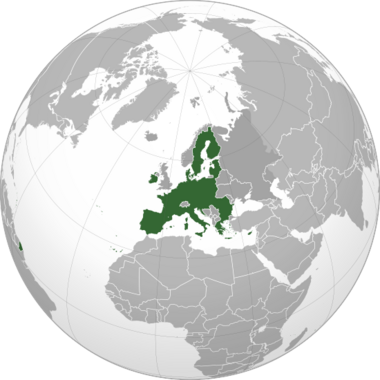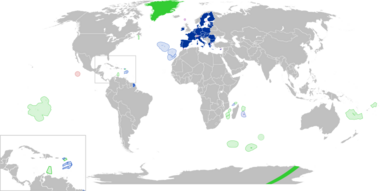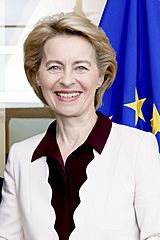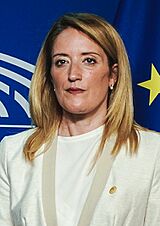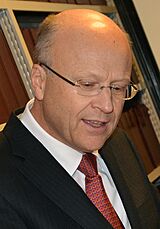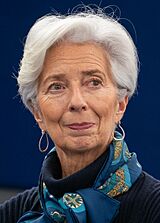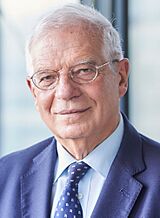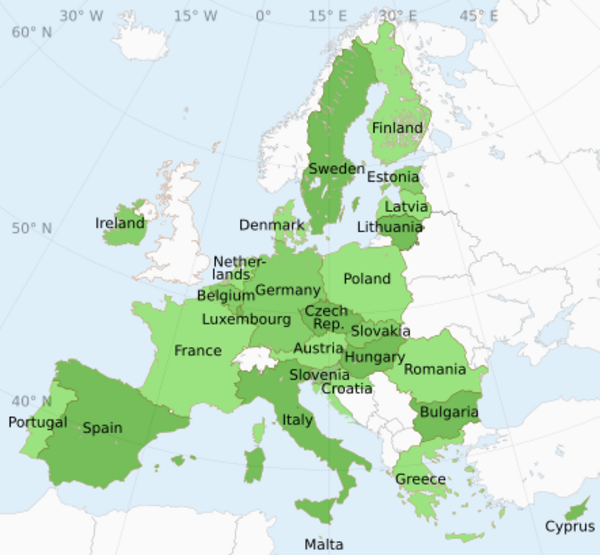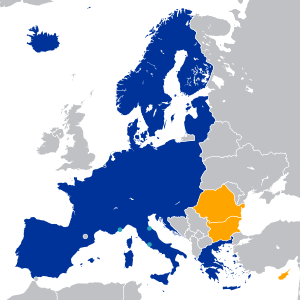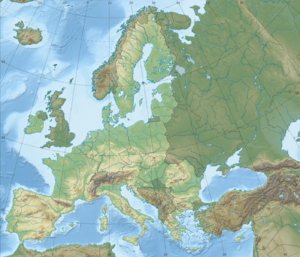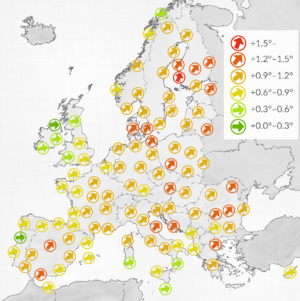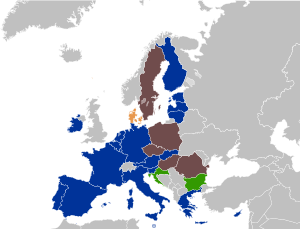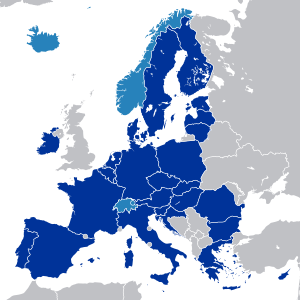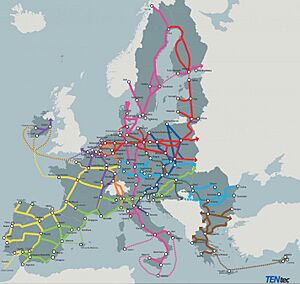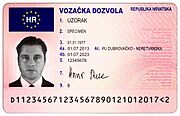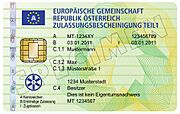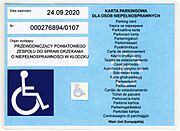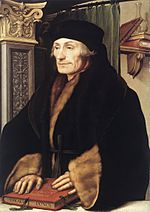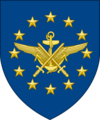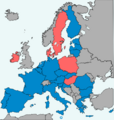European Union facts for kids
Quick facts for kids
European Union
|
|
|---|---|
|
Anthem: "Anthem of Europe"
|
|
|
Location of the European Union (dark green)
on the European continent (dark grey) |
|
| Capital | Brussels (de facto) |
| Institutional seats |
Brussels
Court of Auditors
Court of Justice Council of the EU (April, June and October sessions) Secretariat of the Parliament Commission (various departments and services) Parliament
|
| Largest metropolis | Paris |
| Official languages | 24 languages |
| Official scripts | |
| Religion
(2015)
|
|
| Demonym(s) | European |
| Type | Continental union |
| Membership | |
| Government | Mixed intergovernmental directorial parliamentary confederation |
| Charles Michel | |
| Ursula von der Leyen | |
|
• Presidency of the Council of the European Union
|
|
| Legislature | The European Parliament and the Council |
| Council of the European Union | |
| European Parliament | |
| Formation | |
|
• Treaty of Paris
|
18 April 1951 |
| 1 January 1958 | |
|
• Single European Act
|
1 July 1987 |
| 1 November 1993 | |
| 1 December 2009 | |
| Area | |
|
• Total
|
4,233,262 km2 (1,634,472 sq mi) |
|
• Water (%)
|
3.08 |
| Population | |
|
• 2023 estimate
|
|
|
• Density
|
106/km2 (274.5/sq mi) |
| GDP (PPP) | 2023 estimate |
|
• Total
|
|
|
• Per capita
|
|
| GDP (nominal) | 2023 estimate |
|
• Total
|
|
|
• Per capita
|
|
| Gini (2020) | ▼ 30.0 medium |
| Currency | Euro (€) (EUR) Others
|
| Time zone | UTC to UTC+2 (WET, CET, EET) |
|
• Summer (DST)
|
UTC+1 to UTC+3 (WEST, CEST, EEST) |
| (see also Summer time in Europe) | |
| Internet TLD | .eu, .ею, .ευ |
The European Union (EU) is a special group of 27 countries in Europe. These countries work together on many things, like politics and money. The EU covers a large area of land, about 4.2 million square kilometers. More than 448 million people live there!
The EU is unique because it combines features of different types of unions. It's like a team where countries agree to follow certain rules together. In 2022, the EU countries together produced about one-sixth of the world's total economic output. Most EU countries also have a very high Human Development Index, which means people there generally have a good quality of life.
One of the main goals of the EU is to create a "single market." This means people, goods, services, and money can move freely between member countries. It's like having no borders for trade and travel! For example, you don't need a passport to travel between many EU countries thanks to the Schengen Area. Many EU countries also use the same money, the euro, which makes trade even easier. The EU also works on common policies for things like trade, farming, and helping different regions grow.
The EU also plays a big role in the world. It has its own diplomatic offices and represents its members at important global organizations like the United Nations. Some people even see the EU as a rising global power.
The EU officially started in 1993 with the Treaty of Maastricht. But its roots go back much further, to 1948, when a few countries decided to work together after World War II. Over time, more countries joined, and the EU's power grew. In 2012, the EU won the 2012 Nobel Peace Prize for helping to bring peace and democracy to Europe. The United Kingdom left the EU in 2020, but many other countries are hoping to join in the future.
The European Union's Story: How It Began
Why Countries Decided to Work Together
After the terrible World War I and World War II, many people in Europe wanted to find a way to prevent future wars. They believed that if countries worked closely together, they would be less likely to fight each other. Leaders like Winston Churchill and Robert Schuman suggested creating a "United States of Europe."
In 1948, countries started to form groups to cooperate. One important step was the creation of the European Coal and Steel Community (ECSC) in 1952. Six countries – Belgium, France, Italy, Luxembourg, the Netherlands, and West Germany – joined. The idea was that if these countries shared control over coal and steel, which are important for making weapons, they couldn't secretly prepare for war against each other. This was a big step towards peace and cooperation.
Growing Together: The Early Years
In 1957, the same six countries signed the Treaty of Rome. This created the European Economic Community (EEC), which aimed to build a "common market" where goods could move freely. They also created the European Atomic Energy Community to work together on nuclear energy. These groups shared courts and a common assembly.
Over time, these communities merged their institutions. By 1967, they were all working under one set of rules, known as the European Communities.
More Countries Join and Borders Open
In 1973, Denmark, Ireland, and the United Kingdom joined the Communities. Later, in 1979, people in these countries could directly vote for members of the European Parliament for the first time.
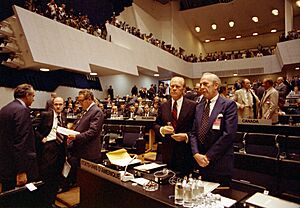
Greece joined in 1981, and Portugal and Spain joined in 1986. A big change happened in 1985 with the Schengen Agreement. This agreement made it possible to travel between most member countries without passport checks, making travel much easier! In 1990, after the fall of the Berlin Wall, East Germany became part of the Communities when Germany reunited.
The European Union Is Born and the Euro Arrives
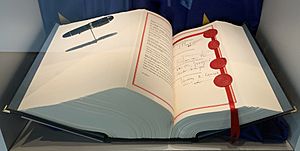
The European Union was officially created on 1 November 1993, when the Treaty of Maastricht came into effect. This treaty gave the group its new name, the European Union. It also set out rules for new countries to join, called the Copenhagen criteria. These rules ensure that new members have a stable democracy, respect human rights, and have a strong economy.
In 1995, Austria, Finland, and Sweden joined. A very important step happened in 2002: the euro banknotes and coins were introduced. This new currency replaced national money in 12 member countries. Today, 20 countries use the euro.
In 2004, the EU had its biggest expansion ever! Ten new countries joined: Cyprus, the Czech Republic, Estonia, Hungary, Latvia, Lithuania, Malta, Poland, Slovakia, and Slovenia.
New Challenges and Changes
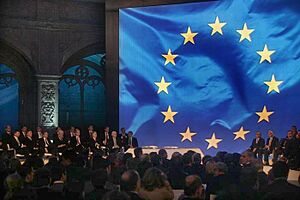
Bulgaria and Romania joined the EU in 2007. In 2009, the Treaty of Lisbon made big changes to how the EU works, making it more efficient.
In 2012, the EU was awarded the 2012 Nobel Peace Prize for its efforts in promoting peace and human rights in Europe. Croatia became the 28th member in 2013.
The 2010s brought some challenges, including economic problems in some countries and a rise in migration. The biggest change was when the United Kingdom decided to leave the EU in 2016. After a process, the UK officially left on 31 January 2020.
More recently, the EU has faced new challenges like the COVID-19 pandemic and the war in Ukraine. The EU countries have worked together to help each other and support Ukraine. The EU is also planning for more countries to join in the future, aiming for over 35 members by 2030.
How the European Union Works
The EU has a special way of making decisions. Member countries agree to give some of their power to the EU as a whole. This means the EU can make laws that apply to all member states in certain areas, like trade or environmental protection. However, countries still keep control over many other areas, such as their own taxes or armies.
EU Money: The Budget
(€1,087 billion)
Sustainable Growth/Natural Resources (38.6%) Competitiveness for Growth and Jobs (13.1%) Global Europe (6.1%) Economic, Territorial and Social Cohesion (34.1%) Administration (6.4%) Security and Citizenship (1.7%)
The EU has a large budget, which was about €170.6 billion in 2022. This money comes from member countries and is used for many things. For example, a big part of the budget goes to supporting farmers and helping different regions develop. Money is also spent on transport, education, research, and foreign policy.
The EU also has special offices to fight fraud and make sure the money is used correctly.
Who Makes the Decisions?
The European Union has seven main groups that make decisions. These are called its institutions. They work together to create and enforce EU laws.
The Leaders: Executive Branch
The EU's executive branch is like its government. It has two main parts:
- The European Council is made up of the leaders (presidents or prime ministers) of each EU country. They meet several times a year to set the main goals and direction for the EU. The President of the European Council, currently Charles Michel, helps lead these meetings.
- The European Commission is like the EU's daily management team. It proposes new laws and makes sure that EU laws are followed. It has 27 members, called Commissioners, one from each country. Each Commissioner is in charge of a different policy area. The President of the European Commission, currently Ursula von der Leyen, leads this team.
Making Laws: Legislative Branch
The EU's laws are made by two main groups:
- The Council of the European Union (also called the "Council of Ministers") is where government ministers from each EU country meet. They discuss and approve laws, depending on the topic. For example, the agriculture ministers would meet to discuss farming laws.
- The European Parliament is made up of 705 members (MEPs) who are directly elected by EU citizens every five years. They represent the people of Europe and work with the Council to approve new laws. The President of the European Parliament, currently Roberta Metsola, leads the Parliament.
Interpreting Laws: Judicial Branch
President of the Court of Justice
The Court of Justice of the European Union (CJEU) makes sure that EU laws are applied fairly and correctly in all member countries. It's like the supreme court for EU law. If countries or institutions disagree about a law, the CJEU helps to interpret it. It also makes sure that national laws don't go against EU law.
Other Important EU Bodies
- The European Central Bank (ECB) manages the euro currency and controls how much money is in circulation in the Eurozone. Its main goal is to keep prices stable. The current president is Christine Lagarde.
- The European Court of Auditors checks that the EU's money is spent correctly and efficiently.
- The European Ombudsman helps people, businesses, and organizations if they have problems with how the EU administration works.
EU Laws: How They Work
EU laws are based on a series of agreements called treaties. These treaties set the goals for the EU and give its institutions the power to make laws.
There are different types of EU laws:
- Regulations become law in all member states as soon as they are passed. They automatically override any conflicting national laws.
- Directives tell member states to achieve a certain result, but they let each country decide how to do it. Countries then create their own national laws to meet the directive's goals.
- Decisions apply only to specific individuals, companies, or countries.
Working with Other Countries: Foreign Relations
The EU countries work together on foreign policy. This means they try to have common goals and actions when dealing with other countries around the world. The aim is to promote the EU's interests, as well as peace, human rights, and democracy globally.
The High Representative of the Union for Foreign Affairs and Security Policy, currently Josep Borrell, speaks for the EU on foreign policy and defense matters. The EU also has its own diplomatic service, called the European External Action Service, which is like a foreign ministry for the EU.
The EU also provides a lot of humanitarian aid to developing countries and helps with international cooperation and development.
Keeping Europe Safe: Defence and Security
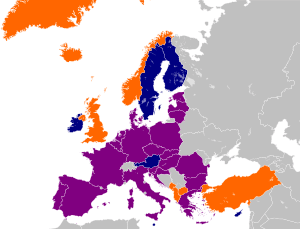
The EU was not created as a military alliance, as many of its members are also part of NATO. However, the EU has been working to improve its ability to respond to international crises. It has special military units called EU Battlegroups that can be quickly deployed.
The EU also has agencies like Frontex (the European Border and Coast Guard Agency) to help manage borders and fight illegal immigration, human trafficking, and terrorism.
Who Are the EU Members?
The EU started with six countries and has grown to 27 members today. When a country joins the EU, it agrees to follow EU laws and gets a say in how the EU is run. This is sometimes called "pooling of sovereignty," meaning countries share some of their power for common goals.
To join the EU, a country must meet certain rules called the Copenhagen criteria. These rules include having a stable democracy, respecting human rights, having a working market economy, and accepting all EU laws.
Some countries in Europe, like Iceland, Liechtenstein, Norway, and Switzerland, are not full EU members. However, they have special agreements that link them closely to the EU's economy.
| State | Joined EU | Population | Area (km²) | MEPs | |
|---|---|---|---|---|---|
| 1 January 1995 | 8,978,929 | 83,855 | 19 | ||
| Founder (1993) | 11,617,623 | 30,528 | 21 | ||
| 1 January 2007 | 6,838,937 | 110,994 | 17 | ||
| 1 July 2013 | 3,862,305 | 56,594 | 12 | ||
| 1 May 2004 | 904,705 | 9,251 | 6 | ||
| 1 May 2004 | 10,516,707 | 78,866 | 21 | ||
| Founder (1993) | 5,873,420 | 43,075 | 14 | ||
| 1 May 2004 | 1,331,796 | 45,227 | 7 | ||
| 1 January 1995 | 5,548,241 | 338,424 | 14 | ||
| Founder (1993) | 67,871,925 | 640,679 | 79 | ||
| Founder (1993) | 83,237,124 | 357,021 | 96 | ||
| Founder (1993) | 10,459,782 | 131,990 | 21 | ||
| 1 May 2004 | 9,689,010 | 93,030 | 21 | ||
| Founder (1993) | 5,060,004 | 70,273 | 13 | ||
| Founder (1993) | 59,030,133 | 301,338 | 76 | ||
| 1 May 2004 | 1,875,757 | 64,589 | 8 | ||
| 1 May 2004 | 2,805,998 | 65,200 | 11 | ||
| Founder (1993) | 645,397 | 2,586 | 6 | ||
| 1 May 2004 | 520,971 | 316 | 6 | ||
| Founder (1993) | 17,590,672 | 41,543 | 29 | ||
| 1 May 2004 | 37,654,247 | 312,685 | 52 | ||
| Founder (1993) | 10,352,042 | 92,390 | 21 | ||
| 1 January 2007 | 19,042,455 | 238,391 | 33 | ||
| 1 May 2004 | 5,434,712 | 49,035 | 14 | ||
| 1 May 2004 | 2,107,180 | 20,273 | 8 | ||
| Founder (1993) | 47,432,893 | 504,030 | 59 | ||
| 1 January 1995 | 10,452,326 | 449,964 | 21 | ||
| 27 total | 446,735,291 | 4,233,262 km2 (1,634,472 sq mi) |
705 | ||
Travel Without Borders: The Schengen Area
The Schengen Area is a special zone of 27 European countries where you can travel without showing your passport at the borders between them. It's like one big country for travel! This makes it much easier for people to move around for holidays, work, or study. Most EU countries are part of the Schengen Area.
Countries Hoping to Join the EU
There are nine countries that are currently candidates to join the EU. These include Albania, Bosnia and Herzegovina, Georgia, Moldova, Montenegro, North Macedonia, Serbia, Turkey, and Ukraine. They are working to meet the EU's rules and standards so they can become members in the future.
Countries That Left the EU
Only two places have left the EU. Greenland, which is a part of Denmark, left in 1985. The United Kingdom is the only country that has left the EU. It officially withdrew in 2020.
Europe's Landscape and Weather
The EU's member countries cover a huge part of the European continent. The highest mountain in the EU is Mont Blanc in the Alps. The EU has a very long coastline, which affects its weather and economy.
Some EU countries also have special territories outside of Europe. For example, the Canary Islands (part of Spain) are off the coast of Africa, and French Guiana (part of France) is in South America. These places are also part of the EU.
Europe's Climate Zones
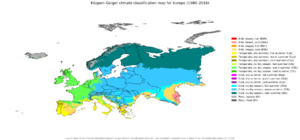
The EU generally has a mild and varied climate. Western parts have a maritime climate with influences from the Gulf Stream, making them warmer than other places at the same latitude. Southern Europe has a mediterranean climate with hot, dry summers. Eastern Europe tends to have a more continental and drier climate.
Protecting the Environment
The EU has a strong focus on protecting the environment. It has created many laws to control air and water pollution, manage waste, and protect nature. The EU is also a leader in fighting climate change.
EU countries have agreed to reduce their carbon dioxide emissions and use more renewable energy. In 2021, the EU passed a European Climate Law that aims for a 55% reduction in greenhouse gas emissions by 2030 and to become carbon neutral by 2050. This means balancing the amount of greenhouse gases released with the amount removed from the atmosphere.
The EU's Economy and Trade
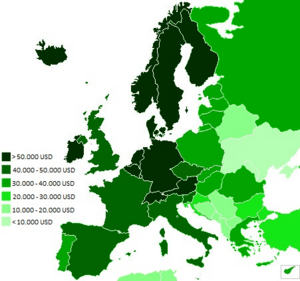
The EU's economy is one of the largest in the world. In 2022, the total economic output of EU countries was about $16.64 trillion. There are differences in wealth between regions, but overall, the EU is very prosperous.
The EU is also a major player in global trade. It is the largest exporter in the world.
The Euro and Banking
The Euro is the official currency for 20 EU member countries. These countries form the eurozone. Using the same currency makes it easier to do business and travel between these countries. The euro is one of the most important currencies in the world.
The European Central Bank (ECB) manages the euro and works to keep prices stable in the eurozone. There are also other financial organizations that help keep the EU's economy strong and stable.
Free Trade and the Single Market
One of the EU's main goals is to have a "single market." This means that goods, money, people, and services can move freely between member countries without extra taxes or checks at borders. This helps businesses grow and gives consumers more choices.
The EU also has a customs union. This means all goods coming into the EU from outside pay the same taxes, no matter which EU country they enter. Once inside, they can move freely.
Energy for Europe
Total energy supply (2019) Oil (31.7%) Natural gas (24.7%) Coal (10.9%) Nuclear (13.2%) Biofuels, waste, electricity, heat (19.4%)
The EU works on energy policy to make sure its countries have enough energy. It aims to increase competition, invest in new energy sources, and connect electricity grids between countries. The EU also wants to use energy more efficiently and increase the use of renewable energy.
Many EU countries rely on energy imports, especially fossil fuels. The EU is working to reduce this dependence, especially on Russian energy, by investing more in clean energy.
Getting Around: Transport
The EU helps manage roads, railways, airports, and waterways that cross borders between countries. This is called the Trans-European Transport Network (TEN-T). It helps people and goods travel smoothly across Europe.
For example, the EU has a network of high-speed trains and works to make sure different national rail systems can connect easily. It also has agencies that help ensure safety in air and sea travel.
- Transport documents used in the European Union
Connecting Europe: Telecommunications and Space
The EU has removed mobile phone roaming charges when you travel between EU countries. This means you can use your phone in another EU country without paying extra fees.
The EU also has its own space program. It has created the Galileo satellite navigation system, which is like a European version of GPS. This system helps with navigation and positioning and is operated by the European Union Agency for the Space Programme (EUSPA).
Farming and Fishing
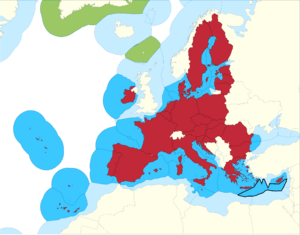
The EU has common policies for farming (the Common Agricultural Policy) and fishing (the Common Fisheries Policy). These policies provide support to farmers and fishermen and set rules for how much fish can be caught to protect marine life.
Helping Regions Grow
The EU has special funds to help less developed regions within its member states. These funds support projects that improve infrastructure, create jobs, and boost the economy in these areas.
Working and Social Rights
EU citizens have the right to live, work, study, or retire in any other EU country. This means it's easier for people to move for new opportunities. The EU also works to protect workers' rights and ensure fair working conditions across its members.
The EU aims to ensure that people have access to social security and healthcare services, even if they move to another EU country. It also promotes equality and fights against discrimination based on things like gender, age, or race.
People and Culture in the EU
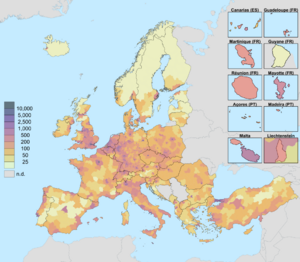
In 2021, about 447 million people lived in the EU. Most people in the EU live in cities. Paris is the largest metropolitan area in the EU, with over 13 million people. Other large cities include Madrid, Barcelona, Berlin, and Milan.
Many Languages, One Union
| Language | Native speakers | Total |
|---|---|---|
| German | 18% | 32% |
| French | 13% | 26% |
| Italian | 12% | 16% |
| Spanish | 8% | 15% |
| Polish | 8% | 9% |
| Romanian | 5% | 5% |
| Dutch | 4% | 5% |
| Greek | 3% | 4% |
| Hungarian | 3% | 3% |
| Portuguese | 2% | 3% |
| Czech | 2% | 3% |
| Swedish | 2% | 3% |
| Bulgarian | 2% | 2% |
| English | 1% | 51% |
| Slovak | 1% | 2% |
| Danish | 1% | 1% |
| Finnish | 1% | 1% |
| Lithuanian | 1% | 1% |
| Croatian | 1% | 1% |
| Slovene | <1% | <1% |
| Estonian | <1% | <1% |
| Irish | <1% | <1% |
| Latvian | <1% | <1% |
| Maltese | <1% | <1% |
The EU has 24 official languages. Important documents and laws are translated into all of them. The most widely spoken language in the EU is English, even though it's not the native language for most people there. German and French are also widely spoken. The EU encourages its citizens to learn different languages.
Religion in Europe
| Affiliation | Per cent of EU population | |
|---|---|---|
| Christian | 71.6 |
|
| Catholic | 45.3 |
|
| Protestant | 11.1 |
|
| Eastern Orthodox | 9.6 |
|
| Other Christian | 5.6 |
|
| Muslim | 1.8 |
|
| Other faiths | 2.6 |
|
| Irreligious | 24.0 |
|
| Non-believer/Agnostic | 13.6 |
|
| Atheist | 10.4 |
|
The EU does not have an official religion. Most people in the EU identify as Christian, but there are also many people with no religious belief, and followers of Islam and other faiths. The EU respects all religions and beliefs.
Learning and Discovery: Education and Research
The EU supports education and research across its member states. One famous program is the Erasmus Programme, which helps university students study in other EU countries. This program has helped millions of students experience life and learning in a different European country.
The EU also funds scientific research to help solve big challenges, like developing new renewable energy sources.
Staying Healthy: Healthcare
The EU works to ensure high standards of health protection for everyone. If you are an EU citizen, you can get a free European Health Insurance Card. This card helps you get emergency medical treatment if you visit another participating European country.
People in the EU generally live long and healthy lives. The average life expectancy in the EU was 80.1 years in 2021, which is much higher than the world average.
Symbols of the European Union
The EU has several symbols that represent its unity and values.
The Flag of Europe
The flag of Europe is blue with a circle of 12 golden stars. The stars stand for the peoples of Europe coming together in a circle, which means unity and perfection. This flag was first designed in 1955 for the Council of Europe and was adopted by the EU's predecessors in 1986.
Motto and Anthem
The EU's motto is "United in Diversity." This means that even though Europe has many different cultures, languages, and traditions, its people are united in their goals. The motto was chosen in 2000 by school pupils.
The EU's anthem is an instrumental version of the "Ode to Joy" from Ludwig van Beethoven's Ninth Symphony. It is played at official EU events.
Other Symbols
The Greek mythological figure of Europa, who was carried away by a bull, is often used as a symbol for Europe. You can see her image on the 2013 series of euro banknotes.
Charles the Great, a famous European emperor from long ago, is also seen as a symbolic "Father of Europe." The EU has named one of its buildings after him, and there's a special prize, the Charlemagne Prize, given to people who work for European unity.
Images for kids
-
Treaty of Paris (1951), establishing the ECSC
-
Signing ceremony of the Treaty of Rome (1957), establishing the ECC
-
Eastern Partnership Summit 2017, Brussels
-
A Schengen visa
(German version) -
A passport, displaying the name of the member state, the national arms and the words "European Union" given in their official language(s)
(Irish version pictured) -
The European emblem emblazoned on the Eiffel Tower
See also
 In Spanish: Unión Europea para niños
In Spanish: Unión Europea para niños



